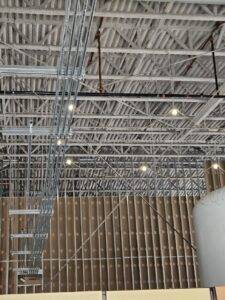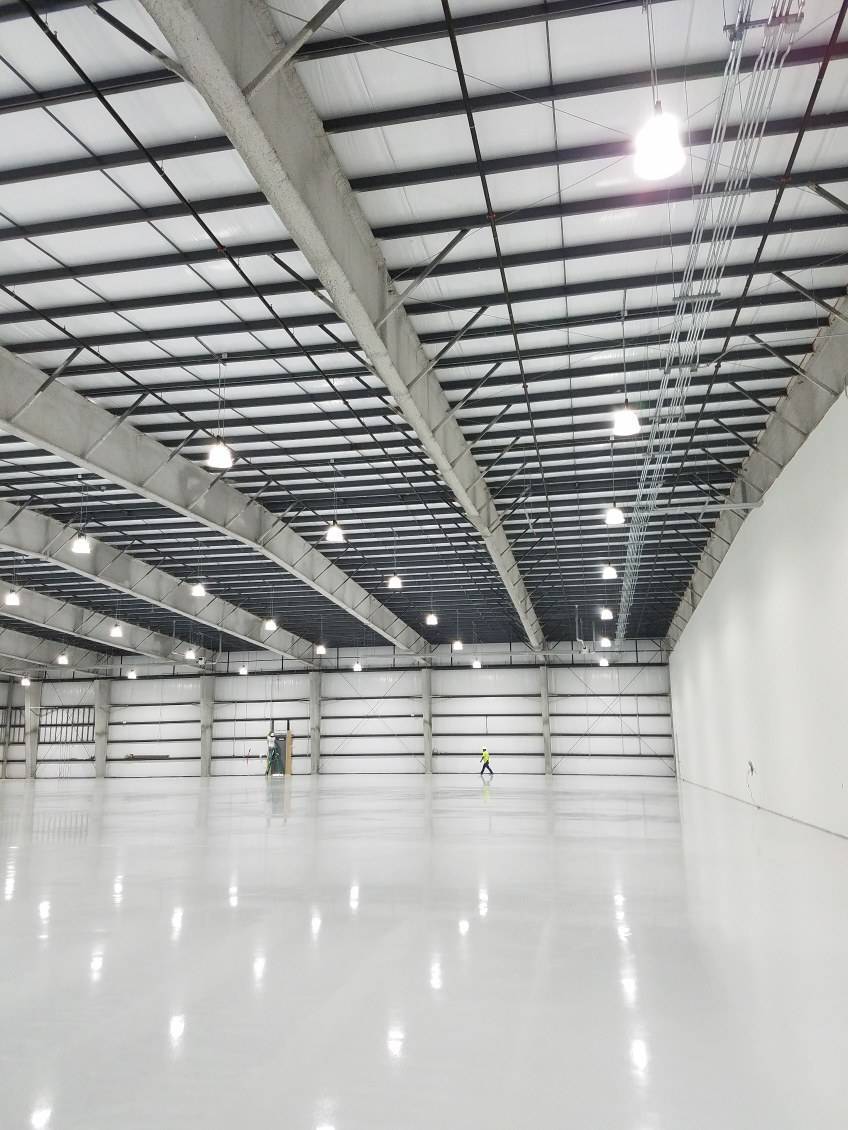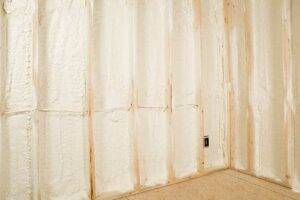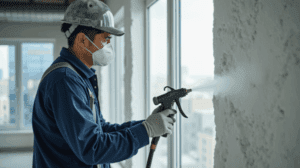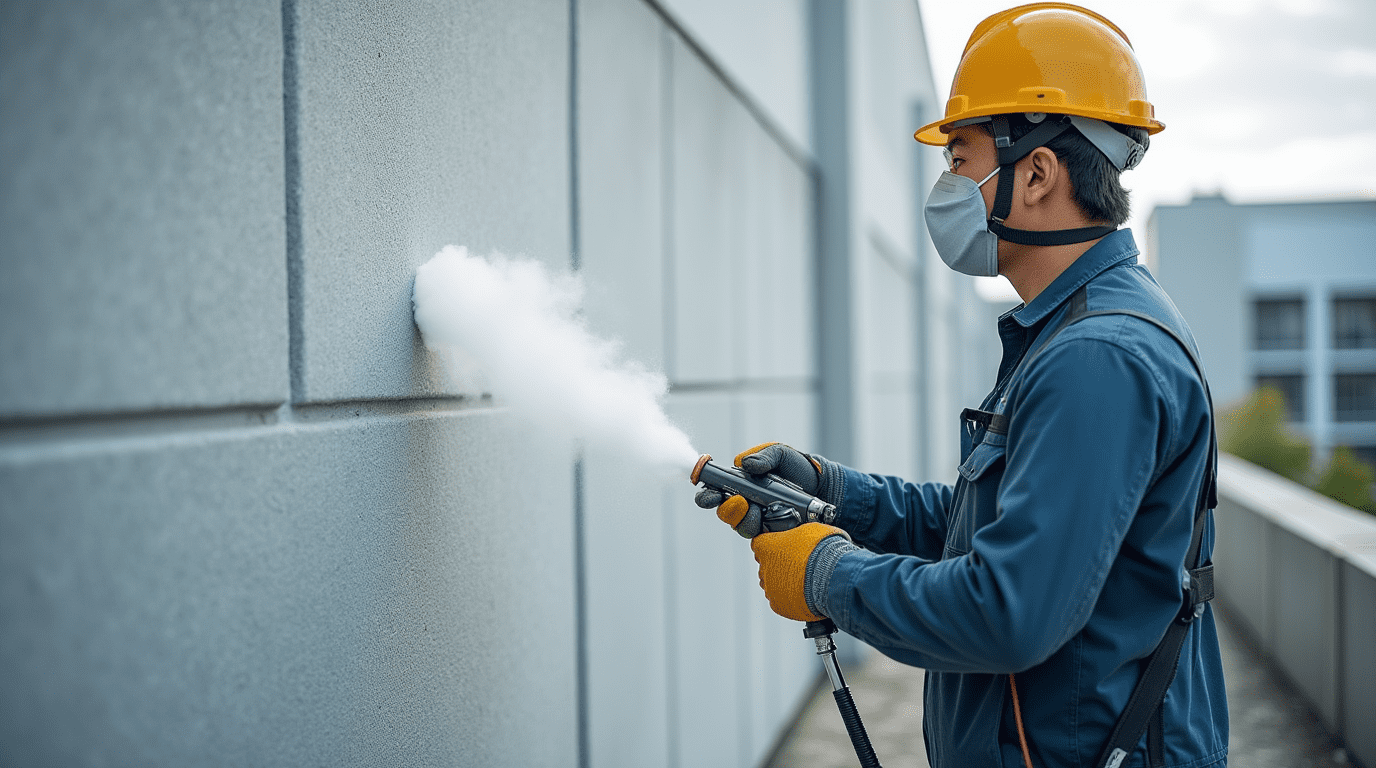Maximize Energy Efficiency with K-13 Insulation Benefits
Bahl Fireproofing
Commercial building owners face relentless pressure to reduce operating costs while meeting stricter energy codes and sustainability targets. K-13 sprayed fiber insulation addresses this challenge by creating a seamless thermal envelope that controls heat transfer, stabilizes interior temperatures, and cuts HVAC consumption. This guide examines K-13’s thermal performance mechanisms, quantifies energy savings potential, explores applications across warehouses and office buildings, and explains how Bahl Fireproofing’s installation expertise maximizes long-term efficiency in commercial facilities throughout Texas, Oklahoma, and Kansas.
TLDR: K-13 spray insulation delivers an R-value of 3.7 per inch through continuous open-cell cellulose coverage that eliminates thermal bridging and air infiltration. Commercial buildings typically achieve 20-30 percent reductions in heating and cooling costs (typical for comprehensive insulation upgrades in previously under-insulated structures) with payback periods of three to five years. Its recycled cellulose composition supports LEED certification while providing superior moisture management compared to traditional batt or foam systems.
Why Energy Efficiency Matters for Commercial Buildings Today
We’ve walked commercial properties where heating and cooling consume 40 to 50 percent of total energy budgets. That’s not sustainable, especially when energy codes keep getting tighter and utility rates keep climbing.
The thermal envelope is where most of that waste happens. Gaps around penetrations, compression in batt insulation, thermal bridging at every structural member. Each flaw lets conditioned air escape and forces HVAC systems to work harder, cycle more frequently, and fail sooner than their rated service life.
K-13 spray-applied insulation solves those problems by forming a continuous barrier that adheres directly to roof decks, walls, and irregular surfaces. No seams, no gaps, no thermal bridges. Just consistent R-value coverage that keeps energy where it belongs and gives building owners control over their largest operating expense.
What Is K-13 Spray-Applied Insulation and How Does It Work?
K-13 spray-applied insulation is a cellulose-based thermal and acoustic product manufactured by International Cellulose Corporation. The material consists of recycled paper fibers treated with fire-retardant additives and applied through specialized spray equipment that bonds the fibers to structural surfaces.
The application process creates a monolithic insulation layer without joints or seams. As technicians spray the cellulose mixture onto roof decks, open ceilings, or wall assemblies, the fibers interlock and adhere to form a continuous thermal barrier. This seamless coverage eliminates the air infiltration pathways that compromise performance in batt or board insulation systems.
K-13’s open-cell fiber structure provides three critical performance benefits:
- Thermal resistance that slows conductive heat transfer through building assemblies
- Air-sealing properties that block convective currents and pressure-driven infiltration
- Moisture buffering that stabilizes R-value performance under varying humidity conditions
The material’s cellulose composition offers advantages over closed-cell spray foams. K-13 uses a water-based binder system that cures without volatile organic compounds, contributing to healthier indoor air quality. The cellulose fibers also provide vapor permeability, allowing moisture to move through the assembly without trapping condensation that can degrade thermal performance or promote mold growth.
Key Properties That Drive K-13’s Energy Efficiency
K-13 spray-applied insulation delivers measurable thermal performance through several interconnected properties. Understanding these characteristics explains why the material outperforms many conventional insulation options in commercial applications.
Thermal Performance:
- R-value of 3.7 per inch creates robust resistance to heat flow
- Open-cell structure with hollow cellulose fibers traps air pockets
- Continuous coverage eliminates thermal bridging at structural members
- Maintains rated performance throughout service life without settling
Air Infiltration Control:
- Seamless application blocks convective air currents
- Adheres to irregular surfaces and fills penetrations
- Reduces building envelope leakage rates measured in blower door testing
- Minimizes pressure-driven moisture transport through assemblies
Moisture Management:
- Vapor-permeable structure prevents trapped condensation
- Cellulose fibers buffer humidity fluctuations in commercial spaces
- Resists mold growth when properly installed with adequate ventilation
- Maintains thermal performance across varying environmental conditions
Acoustic Benefits:
- Achieves NRC 1.00 at 2-inch thickness on solid backing
- Reaches NRC 1.05 at 1.5 inches on ribbed metal deck
- Reduces noise transmission through roof and wall assemblies
- Improves occupant comfort in office and educational environments
These properties combine to create a high-performance thermal envelope that reduces HVAC loads, lowers operating costs, and supports compliance with commercial energy codes throughout Texas, Oklahoma, and Kansas.
How K-13’s R-Value Drives Energy Savings in Commercial Buildings
K-13 spray-applied insulation provides an R-value of 3.7 per inch, establishing effective thermal resistance in commercial wall, ceiling, and roof assemblies. This thermal performance directly reduces the rate of heat transfer through building envelopes, which translates into lower peak load demands and decreased annual energy consumption.
The R-value specification represents the material’s resistance to conductive heat flow under standardized test conditions. In field applications, K-13’s seamless coverage and air-sealing properties often deliver thermal performance that exceeds the nominal R-value because the system eliminates convective heat loss through gaps and seams common in batt or board installations.
R-Value Comparison for Commercial Insulation:
| Insulation Type | R-Value per Inch | Application Method | Air Sealing |
|---|---|---|---|
| K-13 Cellulose Spray | 3.7 | Continuous spray | Integrated |
| Closed-Cell Spray Foam | 6.0-7.0 | Spray expansion | Integrated |
| Open-Cell Spray Foam | 3.6-4.0 | Spray expansion | Integrated |
| Fiberglass Batt | 2.9-3.8 | Manual placement | Separate step |
| Rigid Foam Board | 4.5-6.5 | Panel installation | Seam sealing required |
K-13’s combination of thermal resistance and air-sealing functionality means its effective R-value in field conditions often matches or exceeds materials with higher nominal ratings. The seamless application preserves rated performance throughout the building’s service life without the compression, settling, or gap formation that degrades other insulation types.
For typical commercial applications, K-13 installed at 2 to 3 inches provides R-7.4 to R-11.1, meeting or exceeding code requirements for roof deck insulation in climate zones throughout our service areas. This thermal performance supports right-sized HVAC equipment selection and reduces peak load demands that drive utility demand charges.
Thermal Bridging and How K-13 Eliminates Energy Loss
Thermal bridging occurs wherever structural members (steel joists, wood rafters, metal studs) penetrate the insulation layer and create conductive pathways for heat flow. These bridges can reduce the effective R-value of an assembly by 20 to 40 percent compared to the nominal insulation rating, significantly increasing energy consumption.
K-13 spray application eliminates thermal bridging by covering structural members with a continuous insulation layer. The cellulose fibers adhere directly to metal deck ribs, joist flanges, and irregular surfaces, creating uniform thickness across the entire assembly. This complete encapsulation stops conductive heat transfer at structural penetrations.
Traditional batt insulation must be cut and fitted around structural members, leaving gaps where compression reduces R-value. Rigid foam boards require careful cutting and seam sealing around every joist and penetration, with inevitable gaps that create thermal bridges. K-13’s spray application automatically fills these problem areas during installation.
The energy impact of eliminating thermal bridges is substantial. A warehouse with exposed steel joists at 5 feet on center could see effective ceiling R-value increase from R-15 to R-22 simply by switching from batt insulation between joists to continuous K-13 coverage over the entire assembly. That improved thermal performance translates directly into lower HVAC loads and reduced energy costs throughout the building’s operational life.
Energy Savings and ROI: What Commercial Buildings Can Expect
Commercial buildings that upgrade to K-13 insulation typically achieve measurable reductions in heating and cooling costs. Industry data for comprehensive insulation upgrades in previously under-insulated commercial structures demonstrates energy savings in the 20 to 30 percent range, depending on climate zone, building use, and baseline insulation levels.
These savings accumulate across multiple operational categories:
Direct Energy Cost Reduction:
- Lower natural gas or heating oil consumption during winter months
- Decreased electrical demand for cooling equipment during summer peaks
- Reduced utility demand charges from lower peak HVAC loads
- More stable interior temperatures requiring less thermostat adjustment
Equipment Life Extension:
- Less frequent HVAC cycling reduces wear on compressors and fans
- Right-sized equipment operates closer to design efficiency curves
- Fewer emergency service calls from overworked mechanical systems
- Deferred capital expenditures on premature equipment replacement
Occupant Comfort Improvements:
- More even temperature distribution reduces hot and cold spots
- Stable humidity levels improve perceived comfort
- Better acoustic control from K-13’s sound absorption properties
- Reduced drafts from improved air sealing
Based on industry-standard thermal envelope improvements, commercial facilities typically achieve full return on investment within three to five years through combined energy savings and reduced maintenance costs. Properties with higher baseline energy consumption, older HVAC systems, or minimal existing insulation often see shorter payback periods.
A 50,000 square foot warehouse in Central Texas upgrading from R-5 to R-15 roof insulation could expect annual energy savings of $8,000 to $15,000, depending on operational hours and HVAC efficiency. With K-13 installation costs typically ranging from $1.50 to $3.00 per square foot, the project investment recovers through utility savings within the standard payback window.
K-13 Applications Across Commercial Building Types
K-13 spray-applied insulation adapts to diverse commercial facility requirements and architectural configurations. Its versatility makes it suitable for new construction and retrofit projects across multiple building categories.
Warehouses and Distribution Centers:
- High ceilings with exposed structural members benefit from continuous coverage
- Temperature-sensitive inventory requires stable thermal conditions
- Large roof areas make thermal bridging elimination especially valuable
- Forklift traffic and impact resistance favor spray-applied systems over fragile batts
Office Buildings:
- Open-plan ceilings with HVAC ductwork and lighting need flexible insulation
- Acoustic control from K-13’s high NRC improves workplace productivity
- LEED certification goals align with recycled cellulose content
- Occupied renovations benefit from minimal installation disruption
Educational Facilities:
- Gymnasiums and auditoriums require both thermal and acoustic performance
- Large volumes need superior air sealing to control infiltration
- Fire-resistant properties support code compliance in assembly spaces
- Budget constraints favor cost-effective thermal envelope improvements
Retail and Light Industrial:
- Irregular roof configurations with equipment penetrations need seamless coverage
- Mixed-use spaces benefit from integrated thermal and acoustic control
- Energy code compliance supports permitting and green building requirements
- Retrofit applications minimize downtime during occupied tenant improvements
K-13’s spray application conforms to curved surfaces, fills cavities around penetrations, and provides uniform coverage regardless of substrate complexity. This adaptability reduces installation time and material waste compared to cut-and-fit insulation systems.
Fire Resistance and Code Compliance Considerations
K-13 insulation provides Class A fire-resistant properties for exposed ceiling and wall applications, making it suitable for commercial spaces where finish materials remain visible. The cellulose fibers are factory-treated with fire-retardant additives that achieve flame spread of 5 and smoke development of 5 under ASTM E84 testing, far exceeding the Class A maximum thresholds of 25 and 50.
It’s important to understand K-13’s role in fire protection: this material provides excellent Class A surface fire resistance for exposed decking and walls, but it is not a replacement for structural steel fireproofing (SFRM) on beams and columns. For structural applications requiring ASTM E119 fire-resistance ratings, dedicated spray-applied fire-resistive materials are required. K-13 is UL-listed for application over these structural fireproofing products in specific assemblies where it adds thermal and acoustic benefits to properly fire-protected structures.
According to ASTM E84 standards, properly applied cellulose insulation maintains fire-resistant surface performance under standardized test conditions. This certification supports code compliance for interior finish requirements in commercial construction.
For projects requiring both thermal insulation and structural steel protection, learn more about our intumescent fireproofing solutions. These specialized products are engineered specifically to protect steel beams and columns from collapse during fire events, working in coordination with K-13’s thermal and acoustic benefits.
Bahl Fireproofing’s K-13 Installation Process
Professional installation determines whether K-13 insulation delivers its rated thermal performance and energy savings. Bahl Fireproofing’s systematic approach ensures consistent coverage, proper thickness, and long-term durability across commercial projects throughout Texas, Oklahoma, and Kansas.
Pre-Installation Planning:
- Site assessment evaluates substrate conditions and access requirements
- Thickness calculations determine R-value targets for code compliance
- Containment planning protects occupied spaces and mechanical equipment
- Schedule coordination minimizes disruption to building operations
Application Protocol:
- Surface preparation removes debris and ensures proper adhesion
- Calibrated spray equipment delivers consistent fiber density
- Multiple passes build specified thickness with uniform coverage
- Quality inspections verify absence of voids or thin spots
Post-Installation Verification:
- Thickness measurements confirm R-value compliance at designated points
- Density testing validates proper material application
- Documentation packages support code inspections and closeout requirements
- Client training covers maintenance considerations and long-term performance
Our certified applicators follow manufacturer specifications to deliver K-13 installations that meet thermal performance projections and support energy efficiency goals. With 20 years of fireproofing and insulation expertise, Bahl Fireproofing brings proven project management and technical knowledge to every commercial installation.
Comparing K-13 to Other Commercial Insulation Systems
Understanding how K-13 performs relative to alternative insulation products helps facility owners and contractors make informed decisions for commercial energy efficiency projects.
K-13 vs. Fiberglass Batt Insulation:
K-13 outperforms fiberglass batts by eliminating gaps, compression, and settling that degrade thermal performance over time. While fiberglass offers lower initial material costs, its susceptibility to air infiltration and moisture absorption reduces effective R-value in field conditions. K-13’s seamless coverage and integrated air sealing deliver superior energy savings despite comparable nominal R-values per inch.
K-13 vs. Rigid Foam Board:
Rigid foam boards provide higher R-values per inch but require extensive cutting, fitting, and seam sealing around structural members and penetrations. Each seam represents a potential thermal bridge and air leakage pathway. K-13 conforms to irregular surfaces without cutting waste and automatically fills problem areas during application. The moisture-buffering properties of cellulose also prevent condensation issues common with impermeable foam systems.
K-13 vs. Closed-Cell Spray Foam:
Closed-cell polyurethane foam delivers R-6 to R-7 per inch, approximately double K-13’s thermal resistance. However, closed-cell foam costs significantly more per square foot and requires vapor barrier considerations in many assemblies. K-13’s vapor permeability prevents trapped moisture without additional membrane installations. The recycled cellulose content also supports green building objectives that petroleum-based foams cannot match. For commercial applications where R-15 to R-20 assemblies meet code requirements, K-13 achieves target performance at lower installed cost.
K-13 vs. Open-Cell Spray Foam:
Open-cell spray foam and K-13 deliver comparable R-values per inch (3.6 to 4.0 range) with similar vapor permeability and air-sealing properties. K-13 differentiates through its recycled content, superior acoustic absorption (NRC 1.00-1.05 vs. 0.70 for most spray foams), and freedom from chemical off-gassing concerns. The cellulose composition also provides better fire resistance without additional flame retardant treatments.
Sustainability and Green Building Benefits
K-13 spray-applied insulation supports commercial sustainability objectives through multiple environmental and performance attributes that align with LEED certification requirements and corporate responsibility goals.
Recycled Content: K-13 consists of 80 percent pre-consumer recycled cellulose fibers, diverting paper waste from landfills and reducing demand for virgin materials. This high recycled content contributes to LEED v4 Material and Resources credits.
Energy Performance: Reduced heating and cooling consumption translates directly into lower greenhouse gas emissions from power generation and fossil fuel combustion. Commercial buildings achieving 20-30 percent energy savings through comprehensive insulation upgrades can document substantial carbon footprint reductions.
Indoor Environmental Quality: K-13’s water-based binder system contains no volatile organic compounds, supporting healthier indoor air quality for building occupants. The material’s GREENGUARD Gold certification verifies low chemical emissions, contributing to LEED Indoor Environmental Quality credits.
Durability: K-13 maintains its thermal performance throughout the building’s service life without settling, compression, or degradation. This longevity reduces replacement cycles and long-term material consumption compared to insulation systems that require periodic renewal.
Moisture Management: The vapor-permeable cellulose structure prevents condensation accumulation that can lead to mold growth and indoor air quality problems. Proper moisture control supports healthier building environments and reduces maintenance interventions.
These sustainability attributes position K-13 as a strategic choice for commercial projects pursuing green building certifications, energy performance targets, and environmental responsibility commitments.
Frequently Asked Questions
What types of commercial buildings benefit most from K-13 insulation?
K-13 works exceptionally well in warehouses, distribution centers, offices, educational facilities, and light industrial buildings. The spray application adapts to high ceilings, exposed structural members, and irregular roof configurations common in these facility types. Buildings with large roof areas gain particular advantage from K-13’s seamless thermal coverage and thermal bridging elimination. Retrofit projects in occupied spaces also benefit from the relatively clean installation process compared to batt or board insulation systems.
How does K-13 installation affect building operations during application?
Professional K-13 installation can often proceed in occupied buildings with appropriate containment and scheduling coordination. Our team establishes temporary barriers to isolate work areas from active spaces and coordinates application timing to minimize disruption. The water-based spray system produces no harmful fumes or extended curing odors. Most commercial installations complete within days rather than weeks, allowing rapid return to normal operations. Proper planning ensures mechanical systems, lighting, and sprinklers remain protected throughout the process.
What maintenance does K-13 insulation require after installation?
K-13 requires minimal maintenance once properly installed. The cellulose fibers resist settling and maintain their thermal performance without periodic renewal or treatment. Regular building inspections should verify the insulation remains intact and undamaged. If roof repairs or mechanical modifications require insulation removal, affected areas can be resprayed to restore continuous coverage. Maintaining proper building ventilation and humidity control helps preserve K-13’s moisture-buffering capabilities and long-term performance.
Can K-13 insulation be applied in retrofit projects without major disruption?
Yes, K-13’s spray application makes it highly suitable for retrofit installations in existing commercial buildings. The system fills voids and covers irregular surfaces without extensive demolition or structural modifications. Containment procedures protect occupied spaces and building systems during application. Many warehouse and office retrofits proceed in phases to maintain partial building operations throughout the project. The ability to upgrade thermal performance without major reconstruction makes K-13 cost-effective for older facilities seeking energy efficiency improvements.
How does K-13 perform in different climate zones?
K-13 delivers consistent thermal performance across all climate zones served by Bahl Fireproofing, including Texas, Oklahoma, and Kansas. The R-3.7 per inch rating applies regardless of outdoor temperature extremes. The vapor-permeable structure adapts to both cooling-dominated climates (where interior moisture moves outward) and heating-dominated regions (where exterior moisture moves inward). Proper thickness specifications account for local energy code requirements and specific heating or cooling load priorities in each climate zone.
What building codes and energy standards does K-13 help satisfy?
K-13 spray-applied insulation supports compliance with International Building Code requirements for thermal envelope performance, ASHRAE 90.1 energy efficiency standards, and local jurisdictional amendments throughout our service areas. The material’s verified R-value and air-sealing properties facilitate documentation for plan approvals and final inspections. Third-party testing results and manufacturer certifications provide the technical data required for code compliance submittals. When combined with comprehensive air-sealing strategies, K-13 installations meet prescriptive and performance-based energy code pathways.
What is the expected lifespan of K-13 insulation in commercial applications?
K-13 insulation provides reliable performance for 20 years or more when properly installed and maintained, consistent with properly installed cellulose insulation systems. The cellulose fibers resist degradation from normal environmental conditions and do not settle or compress over time. Documented case studies, including the Kansas City International Airport installation showing excellent performance after 18 years, demonstrate K-13’s long-term durability in demanding commercial environments. This extended service life ensures that initial investment continues delivering energy savings throughout the building’s operational lifetime.
How does K-13 compare in cost to other commercial insulation systems?
K-13 installed costs typically range from $1.50 to $3.00 per square foot, depending on thickness requirements, site access, and project scale. This pricing generally falls between fiberglass batt systems (lower initial cost but inferior performance) and closed-cell spray foam (higher R-value per inch but significantly higher cost). When lifecycle energy savings and reduced maintenance are factored into total cost analysis, K-13 often delivers the best economic value for commercial applications requiring R-15 to R-20 thermal performance. Facility owners can obtain detailed project estimates through Bahl Fireproofing’s bid request process.
Key Takeaways
- K-13 spray-applied insulation delivers R-3.7 per inch thermal resistance through continuous open-cell cellulose coverage that eliminates thermal bridging and air infiltration in commercial roof and wall assemblies
- Commercial buildings typically achieve 20-30 percent reductions in heating and cooling costs with industry-standard insulation upgrades, supporting payback periods of three to five years based on utility savings and reduced HVAC maintenance
- The seamless spray application adapts to irregular surfaces, fills penetrations automatically, and covers structural members without gaps or compression that degrade thermal performance in batt or board systems
- K-13’s 80 percent pre-consumer recycled content, GREENGUARD Gold certification, and superior acoustic properties (NRC 1.00-1.05 depending on thickness) support LEED certification and sustainable building objectives
- Professional installation by certified applicators ensures consistent thickness, proper density, and long-term thermal performance that meets energy code requirements and delivers projected energy savings
- The material provides Class A surface fire resistance (flame spread 5, smoke developed 5) for exposed applications but works in coordination with structural fireproofing for steel protection, not as a replacement
Reduce Your Commercial Building’s Energy Costs with K-13
If your facility’s heating and cooling expenses consume too much of your operating budget, K-13 spray-applied insulation offers a proven path to measurable savings and improved comfort. Our team brings two decades of commercial insulation expertise to projects throughout Texas, Oklahoma, and Kansas. delivering installations that meet energy code requirements and support long-term efficiency goals. Contact Bahl Fireproofing today to discuss your project requirements and request a detailed bid.
Disclaimer: This article provides general educational information about fireproofing and insulation systems and does not constitute professional engineering advice or product specification. System selection must be based on project-specific fire ratings, thermal requirements, acoustic performance needs, environmental conditions, substrate requirements, and budget constraints. Code requirements vary by jurisdiction and project type. Always consult with a licensed professional and verify UL or FM assembly listings before finalizing specifications.

